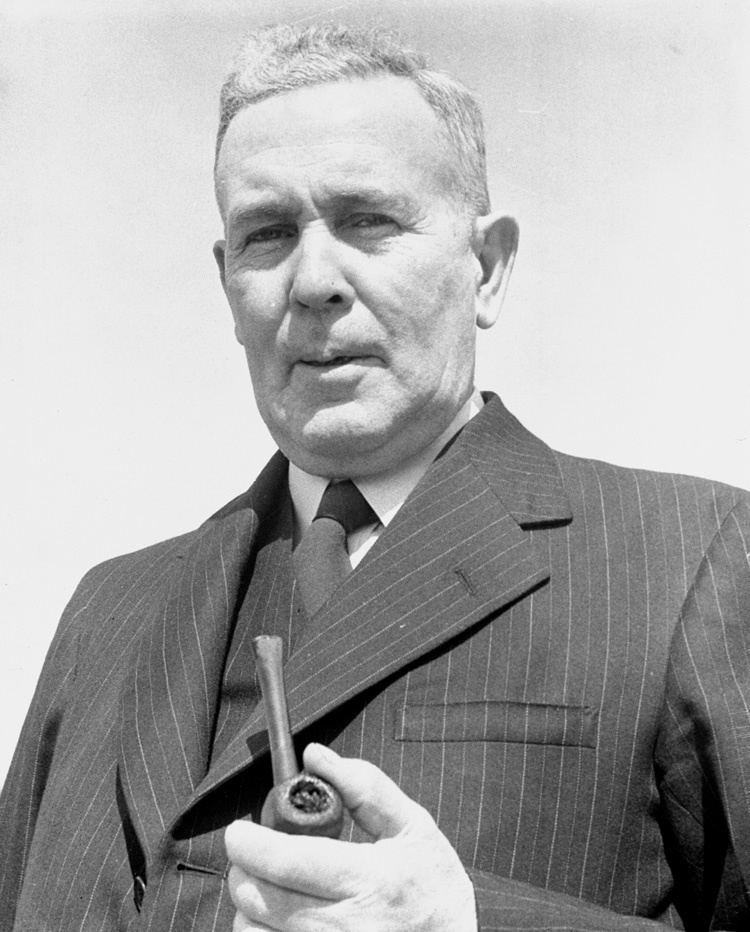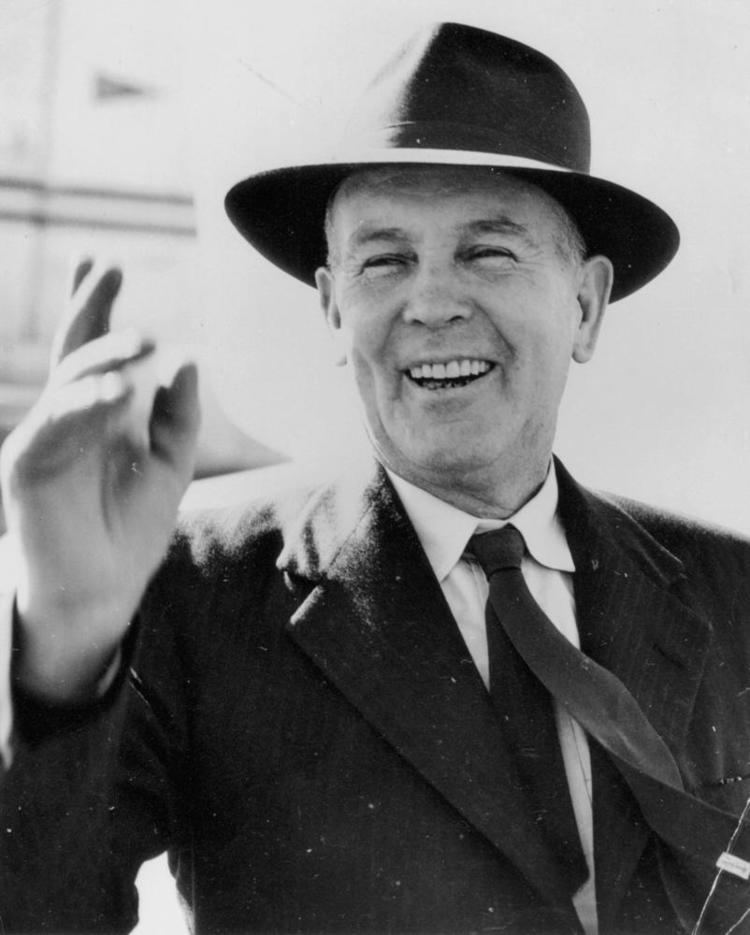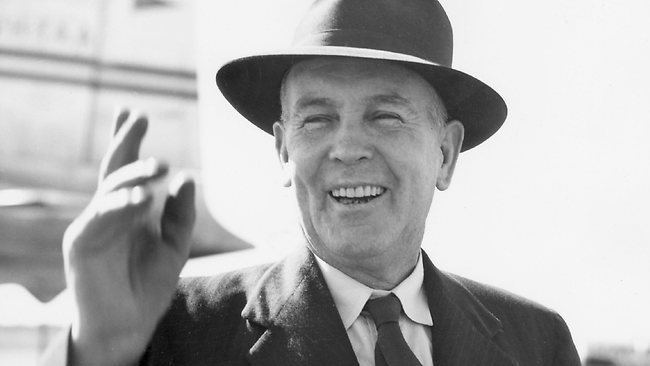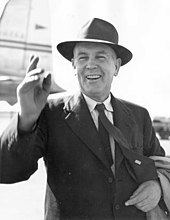Name Ben Chifley | ||
 | ||
Governor-General The Duke of GloucesterSir William McKell Deputy Frank FordeH. V. Evatt Deputy Frank FordeH. V. Evatt Similar People Robert Menzies, Elizabeth Chifley, Harold Holt, Kevin Rudd, Julia Gillard | ||
Prime minister ben chifley makes an address on 2gb 1949
Joseph Benedict Chifley (; 22 September 1885 – 13 June 1951) was an Australian politician who was the 16th Prime Minister of Australia from 1945 to 1949. Following the death of John Curtin, he became Leader of the Labor Party and was successful at the 1946 election, retaining a majority in both Houses of the Australian Parliament, and marking the first time that an incumbent federal Labor government was re-elected. The Chifley Government was defeated at the 1949 election.
Contents
- Prime minister ben chifley makes an address on 2gb 1949
- Rupert quotes ben chifley
- Early life
- Parliament
- Treasurer
- Prime minister
- Legislative achievements
- Bank nationalisation and 1949 coal strike
- Opposition
- Death
- Legacy
- Honours
- References

The radical reforming nature of the Chifley Government was such that, between 1946–49, the Australian Parliament passed 299 Acts, a record up until then, and well beyond the previous record of the Labor Government of Andrew Fisher, which passed 113 Acts from 1910-13.

Amongst the Chifley Labor Government's legislation was the post-war immigration scheme, the establishment of Australian citizenship, the Snowy Mountains Scheme, over-viewing the foundation of airlines Qantas and Trans Australia Airlines, improvements in social services, the creation of the Commonwealth Employment Service, the introduction of federal funds to the States for public housing construction, the establishment of a Universities Commission for the expansion of university education, the introduction of a Pharmaceutical Benefits Scheme (PBS) and free hospital ward treatment, the reorganisation and enlargement of the CSIRO, the establishment of a civilian rehabilitation service, the founding of the Australian Security Intelligence Organisation (ASIO), and the establishment of the Australian National University.

One of the few successful referendums to modify the Australian Constitution, the 1946 Social Services referendum, took place during Chifley's term.

Rupert quotes ben chifley
Early life
Born on 22 September 1885 in Bathurst, New South Wales, Chifley was the son of a blacksmith of Irish Roman Catholic descent. Chifley was raised mostly by his grandfather for nine years. His grandfather had lost his savings in the bank crash of 1892/93, and Chifley acquired a lifelong dislike of private banks at an early age. He was educated at Roman Catholic schools in Bathurst and joined the New South Wales Railways in 1903.
Chifley became an engine driver. He was one of the founders of the AFULE (the Australian Federated Union of Locomotive Enginemen) and an active member of the Labor Party.
In 1914 he married Elizabeth McKenzie, a Presbyterian. The couple exchanged wedding vows in a Presbyterian church. Chifley remained a practising Catholic, but his marriage to a non-Catholic ignited criticism in certain Roman Catholic circles. In 1917 he was one of the leaders of a prolonged strike, which resulted in his dismissal. He was reinstated by Jack Lang's New South Wales Labor government. Chifley represented his union before industrial tribunals and taught himself industrial law.
Parliament
On his second try at the 1928 federal election, Chifley won the Division of Macquarie in the House of Representatives, which covered Bathurst, Lithgow, and the Blue Mountains. He was in general a supporter of the James Scullin government's economic policies, and in 1931 he became Minister for Defence. At the 1931 federal election, the Scullin government was defeated in a landslide and Chifley lost his seat on a 16-point swing to the UAP's John Lawson. During the Great Depression in Australia he survived on his wife's family's money and his part-ownership of the Bathurst newspaper the National Advocate.
In 1935 the Lyons government appointed him a member of the Royal Commission on Banking, a subject on which he had become an expert. He submitted a minority report advocating that the private banks be nationalised. After an unsuccessful effort to win back Macquarie at the 1934 election, Chifley finally won his seat back at the 1940 election on a swing of 10 percent.
Treasurer
Chifley was appointed Treasurer of Australia (finance minister) when Labor leader John Curtin formed a mid-term Labor government in 1941 following the collapse of the first Menzies government.
Although deputy Labor leader Frank Forde was nominally the number-two-man in the government, Chifley became the minister Curtin most relied on, controlling most domestic policy while Curtin was preoccupied with World War II. Of highest importance was war funding, followed by the strong desire to control inflation. In February 1942 he announced the pegging of wages and profits, the introduction of controls on production, trade and consumption to reduce private spending, and the transfer of surplus personal income to savings and war loans. On 15 April 1942 more price controls were introduced. On 23 July a uniform income tax, giving the Commonwealth a monopoly in this vital field, was attained when the States were defeated in the High Court of Australia.
The Australian Dictionary of Biography claims Chifley proved himself to be his country's greatest treasurer – fiscally responsible, able to transmit the necessity for a reasonable equality of sacrifice, and capable of managing a wartime economy of complexity and difficulty. Financing the war by increased taxation, loans from the Australian public, and central bank credit, he ensured that the nation did not become burdened with overseas debt, as it had been after World War I. Every budget was accompanied by his strictures on 'vigorous self-denial', labour discipline and restriction of consumer demand with the aim of controlling a huge accumulation of purchasing power.
Prime minister
When Curtin died in July 1945, Forde became Prime Minister for eight days. Chifley defeated him in the leadership ballot, replacing him as Prime Minister and Curtin as Labor leader. Once the war ended a month later, normal political life resumed, and Chifley faced Robert Menzies and his new Liberal Party in the 1946 election, which Chifley won with 54 percent of the two-party-preferred vote. It marked the first time that an incumbent federal Labor government was re-elected. In the post-war years, Chifley maintained wartime economic controls, including the highly unpopular petrol rationing. He did this partly to help Britain in its postwar economic difficulties.
Legislative achievements
Feeling secure in an unprecedented second term of office, post-WW2 Labor under Chifley looked toward incremental policies friendly to the Labor platform objective of democratic socialism. According to a biographer of Chifley, his government embarked upon greater "general intervention and planning in economic and social affairs", with its policies directed towards better conditions in the workplace, full employment, and an improvement in the "equalisation of wealth, income and opportunity". Chifley was successful in transforming the wartime economy into a peacetime economy, and undertook a number of social welfare initiatives, as characterised by fairer pensions and unemployment and sickness benefits, the construction of new universities and technical colleges, and the building of 200,000 houses between 1945 and 1949.
Among other measures, the Chifley government passed legislation to establish universal health care modeled on the British National Health Service, including a free formulary of essential medicines. This was successfully opposed in the High Court of Australia by the British Medical Association (precursor of the Australian Medical Association).
Chifley then organised one of the few successful constitutional referenda to insert a new section 51xxiiiA which permitted federal legislation over pharmaceutical benefits. It authorised federal legislation over medical and dental services (but not so as to authorise any form of civil conscription), together with family allowances, benefits to students and hospital benefits, child endowment, widows' pensions, unemployment benefits, and maternity allowances. The subsequent federal legislation in relation to pharmaceutical benefits was deemed constitutional by the High Court. This paved the way for the Pharmaceutical Benefits Scheme (PBS), an important component of Australia's modern public health system.
The 1946 referendum made possible many of the Chifley Labor government's other legislative initiatives in social welfare and social provision, including the following:
That same year, eligibility for a Class D pension was extended to women whose husbands were imprisoned for six months or more and were over 50 years old;
The achievements of both Chifley's government and those of the previous Curtin Government in expanding Australia's social welfare services (as characterised by a tenfold increase in commonwealth expenditure on social provision between 1941 and 1949) were brought together under the Social Services Consolidation Act of 1947, which consolidated the various social services benefits, liberalised some existing social security provisions, and increased the rates of various benefits.
Among the government's other legislative achievements were:
The radical reforming nature of Chifley's government was such that between 1946 and 1949, the Australian Parliament enacted 299 bills, a record at that time. Chifley and his ministers were able to ensure that Australia's wartime economy was managed effectively and that post-war debts were minimised.
In addition, ex-service personnel were eased back into civilian life (avoiding the hardship and dislocation that had occurred after the end of the First World War), while a series of liberal measures were carried out which bore fruit during the economic boom of the Fifties and Sixties. As noted by one historian, Chifley's government "balanced economic development and welfare support with restraint and regulation and provided the framework for Australia's post-war economic prosperity."
Bank nationalisation and 1949 coal strike
In 1947, Chifley announced the government's intention to nationalise the banks. This provoked massive opposition from the press, and middle-class opinion turned against Labor. The High Court found Chifley's legislation to be unconstitutional. The government appealed the decision in the Privy Council, but it upheld the High Court's decision.
Chifley's government did, however, succeed in passing the Banking and Commonwealth Bank Acts of 1945, which gave the government control over monetary policy and established the Commonwealth Bank as Australia's national bank.
A prolonged and bitter strike in the coal industry began in June 1949 and caused unemployment and hardship. Chifley saw the strike as a move by the Communist Party to challenge Labor's place as the party of the working class, and he sent in the army to break the strike.
Despite this, Menzies exploited the rising Cold War hysteria to portray Labor as soft on Communism. These events, together with a perception that Chifley and Labor had grown increasingly arrogant in office, led to the Liberal election victory at the 1949 election. While Labor won an additional four seats in a House of Representatives that had been expanded from 74 seats to 121 seats, Menzies and the Coalition won an additional 48. Labor retained a Senate majority however.
Opposition
Chifley was now aged 64 and in poor health (like Curtin, he was a lifelong smoker), but he refused to retire from politics. Though out of government, having retained a Senate majority, Chifley continued as Labor leader and became Leader of the Opposition. The opposition Senate majority would frequently ensure the passing of Labor amendments, or outright blocking, of Menzies Government legislation.
Menzies responded by introducing a bill to ban the Communist Party of Australia in 1950. He expected Chifley to reject it and give him an excuse to call a double dissolution election. Menzies apparently hoped to repeat his "soft-on-Communism" theme to win a majority in both chambers.
However, Chifley let the bill pass after a redraft (it was ultimately thrown out by the High Court). However, when Chifley rejected Menzies' Commonwealth Banking Bill a few months later, Menzies called a double dissolution election for April 1951. Although Chifley managed to lead Labor to a five-seat swing in the House, Labor lost six seats in the Senate, giving the Coalition control of both chambers.
Death
A few weeks later on 13 June 1951, Chifley suffered a heart attack in his room at the Hotel Kurrajong in Canberra.
Chifley at first made light of the sudden chest pains and attempted to dissuade his secretary and confidante, Phyllis Donnelly, who was making him a cup of tea, from calling a doctor. As his condition deteriorated, however, Donnelly called Dr. John Holt, who ordered Chifley's immediate removal to hospital. Chifley died in an ambulance on the way to the Canberra Community Hospital. He was pronounced dead at 10:45 pm.
Menzies heard of Chifley's demise while attending a parliamentary ball at King's Hall in Parliament House to celebrate the 50th Jubilee of Federation (Chifley was invited but had declined to attend). Menzies was deeply distressed and abandoned his normally impassive demeanour to announce in a halting subdued voice:
It is my very sorrowful duty during this celebration tonight to tell you that Mr Chifley has died. I don't want to try to talk about him now because, although we were political opponents, he was a friend of mine and yours, and a fine Australian. You will all agree that in the circumstances the festivities should end. It doesn't matter about party politics on an occasion such as this. Oddly enough, in Parliament we get on very well. We sometimes find we have the warmest friendships among people whose politics are not ours. Mr Chifley served this country magnificently for years.
Legacy
More than 30 years after his death, Chifley's name still aroused partisan passions. In 1987 the New South Wales Labor government decided to name the planned new university in Sydney's western suburbs Chifley University. When, in 1989, a new Liberal government renamed it the University of Western Sydney, controversy broke out. According to a debate on the topic, held in 1997 after the Labor Party had regained government, the decision to rename Chifley University reflected a desire to attach the name of Western Sydney to institutions of lasting significance, and that idea ultimately received the support of Bob Carr, later the Premier of New South Wales.
Honours
Places and institutions that have been named after Chifley include:
In 1975 he was honoured on a postage stamp bearing his portrait issued by Australia Post.
One of the locomotives driven by Chifley, 5112, is preserved on a plinth at the eastern end of Bathurst railway station.
